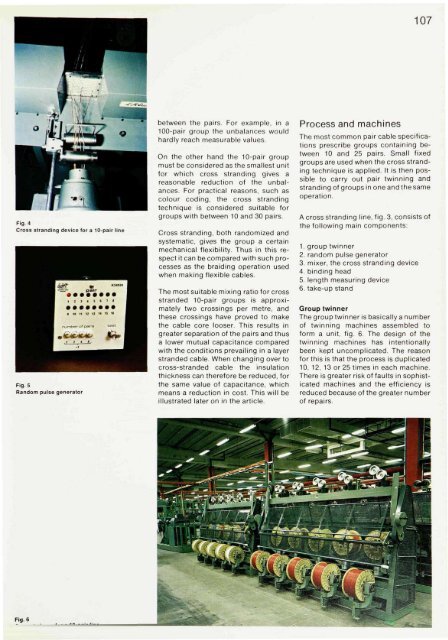Selection and Testing of Electronic Components for LM
Selection and Testing of Electronic Components for LM
Selection and Testing of Electronic Components for LM
You also want an ePaper? Increase the reach of your titles
YUMPU automatically turns print PDFs into web optimized ePapers that Google loves.
Fig. 4<br />
Cross str<strong>and</strong>ing device <strong>for</strong> a 10-pair line<br />
Fig. 5<br />
R<strong>and</strong>om pulse generator<br />
Fig. 6<br />
between the pairs. For example, in a<br />
100-pair group the unbalances would<br />
hardly reach measurable values.<br />
On the other h<strong>and</strong> the 10-pair group<br />
must be considered as the smallest unit<br />
<strong>for</strong> which cross str<strong>and</strong>ing gives a<br />
reasonable reduction <strong>of</strong> the unbalances.<br />
For practical reasons, such as<br />
colour coding, the cross str<strong>and</strong>ing<br />
technique is considered suitable <strong>for</strong><br />
groups with between 10 <strong>and</strong> 30 pairs.<br />
Cross str<strong>and</strong>ing, both r<strong>and</strong>omized <strong>and</strong><br />
systematic, gives the group a certain<br />
mechanical flexibility. Thus in this respect<br />
it can be compared with such processes<br />
as the braiding operation used<br />
when making flexible cables.<br />
The most suitable mixing ratio <strong>for</strong> cross<br />
str<strong>and</strong>ed 10-pair groups is approximately<br />
two crossings per metre, <strong>and</strong><br />
these crossings have proved to make<br />
the cable core looser. This results in<br />
greater separation <strong>of</strong> the pairs <strong>and</strong> thus<br />
a lower mutual capacitance compared<br />
with the conditions prevailing in a layer<br />
str<strong>and</strong>ed cable. When changing over to<br />
cross-str<strong>and</strong>ed cable the insulation<br />
thickness can there<strong>for</strong>e be reduced, <strong>for</strong><br />
the same value <strong>of</strong> capacitance, which<br />
means a reduction in cost. This will be<br />
illustrated later on in the article.<br />
Process <strong>and</strong> machines<br />
107<br />
The most common pair cable specifications<br />
prescribe groups containing between<br />
10 <strong>and</strong> 25 pairs. Small fixed<br />
groups are used when the cross str<strong>and</strong>ing<br />
technique is applied. It is then possible<br />
to carry out pair twinning <strong>and</strong><br />
str<strong>and</strong>ing <strong>of</strong> groups in one <strong>and</strong> the same<br />
operation.<br />
A cross str<strong>and</strong>ing line, fig. 3, consists <strong>of</strong><br />
the following main components:<br />
1. group twinner<br />
2. r<strong>and</strong>om pulse generator<br />
3. mixer, the cross str<strong>and</strong>ing device<br />
4. binding head<br />
5. length measuring device<br />
6. take-up st<strong>and</strong><br />
Group twinner<br />
The group twinner is basically a number<br />
<strong>of</strong> twinning machines assembled to<br />
<strong>for</strong>m a unit, fig. 6. The design <strong>of</strong> the<br />
twinning machines has intentionally<br />
been kept uncomplicated. The reason<br />
<strong>for</strong> this is that the process is duplicated<br />
10, 12, 13 or 25 times in each machine.<br />
There is greater risk <strong>of</strong> faults in sophisticated<br />
machines <strong>and</strong> the efficiency is<br />
reduced because <strong>of</strong> the greater number<br />
<strong>of</strong> repairs.
















